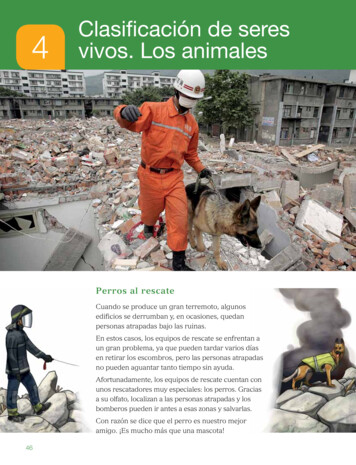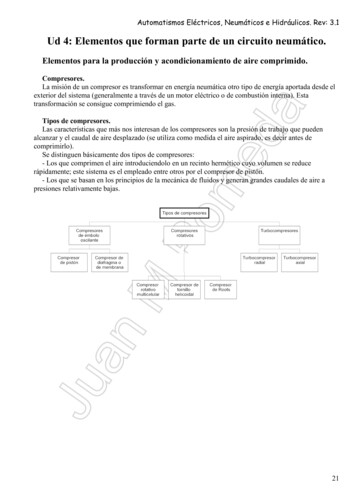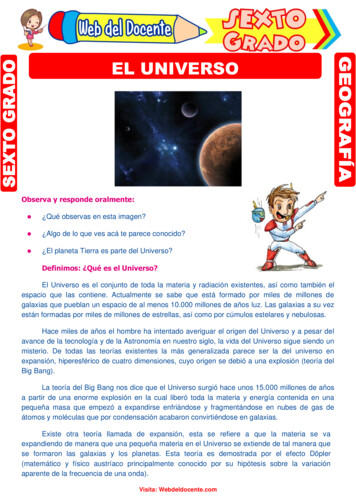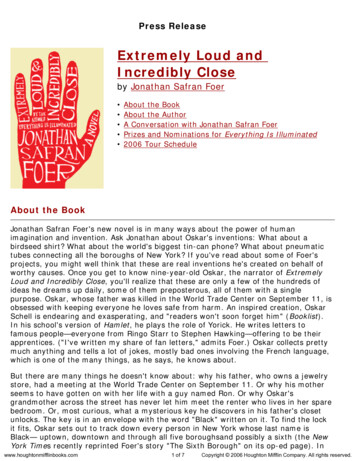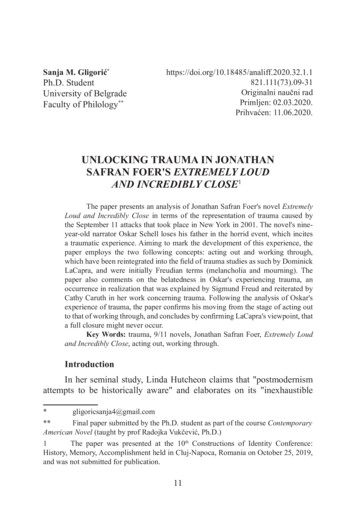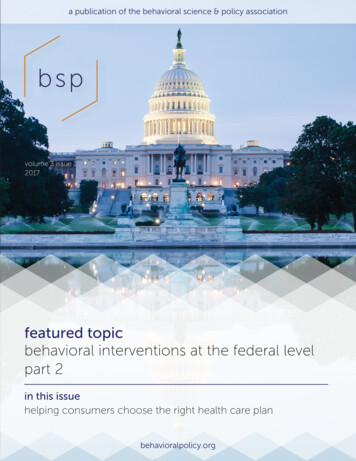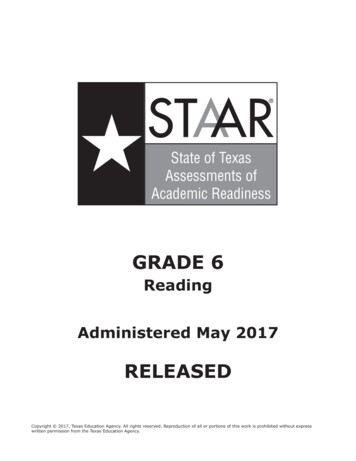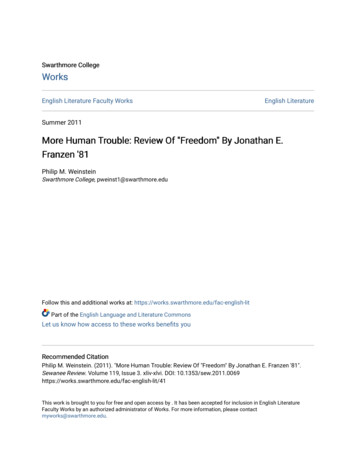
Transcription
1
Jonathan E. Forman, Ph.D.OPCW Science Policy Adviser andSecretary to the Scientific Advisory Board2
International Science Collaboration and the OPCW3
International Science Collaboration and the OPCW4
International Science Collaboration and the OPCW5
International Science Collaboration and the OPCW6
Implementing the ConventionThe ChemicalWeapons ConventionDisarmament(Destruction ernationalCooperationAssistance andProtection against CWs7
Implementing the ConventionThe ChemicalWeapons ConventionDisarmament(Destruction ernationalCooperationAssistance andProtection against CWs8
Implementing the ConventionThe ChemicalWeapons ConventionOPCW-IUPAC MoU 2016Disarmament(Destruction ernationalCooperationAssistance andProtection against CWs9
IUPAC and OPCW Collaboration Predates the MoU!IUPAC organized workshops held in2001, 2007 and 2012 formed thebasis of the Reports of theScientific Advisory Board to theFirst, Second and Third ReviewConferences10
IUPAC and OPCW Collaboration Predates the MoU!IUPAC organized workshops held in2001, 2007 and 2012 formed thebasis of the Reports of theScientific Advisory Board to theFirst, Second and Third ReviewConferences11
Meeting Participation and Support12
Meeting Participation and Support13
Meeting Participation and Support14
Committees and Working Groups15
Committees and Working Groups16
Committees and Working GroupsIUPAC is a permanent observer to the ABEO17
Promoting OPCW in Scientific LiteratureEndorsed by18
Promoting OPCW in Scientific LiteratureEndorsed by19
Promoting OPCW in Scientific LiteratureEndorsed by20
Ethical Codes and Guidelines21
Ethical Codes and Guidelines22
Taking a Partnership to the Next Level23
IUPAC-OPCW CollaborationProf Richard Hartshorn – IUPAC Secretary Generaland members of the IUPAC Delegation24
VISION IUPAC is an indispensable resourcefor chemistry.25
MISSION The International Union of Pure and AppliedChemistry is the global organization thatprovides objective scientific expertise anddevelops the essential tools for theapplication and communication of chemicalknowledge for the benefit of humankindand the world.26
MISSION The International Union of Pure and AppliedChemistry accomplishes its mission by Fostering sustainable development Providing a common language forchemistry Advocating the free exchange of scientificinformation27
A DVA N C I NG C H E M I ST RY WO R L D W I DETwo Global Celebrations in 2019100 YEARS of CREATING ACOMMON LANGUAGE FORCHEMISTRY29
A DVA N C I NG C H E M I ST RY WO R L D W I DEIUPAC in it’s First CenturyDevelopment of the Language of Chemistry Nomenclature, Symbols, TerminologyStandardisation of Chemistry Methods Data Presentation Study of Analytical MethodsCritical Evaluation of Physico-Chemical Data Atomic Weights Thermodynamic Data Kinetic Data30
A DVA N C I NG C H E M I ST RY WO R L D W I DEMore IUPAC Activities Data Exchange Standards for Computers and Instruments Endorsement of International Conferences Biennial IUPAC Congress More than 30 Specialised Symposia each Year Chemistry Education Industrial Safety and Environmental Programs ChemRAWN Conferences addressing Chemistry and WorldNeeds ICGCSD Conferences and Summer Schools on GreenChemistry31
A DVA N C I NG C H E M I ST RY WO R L D W I DEIUPAC’s Color BooksChemical TerminologyGold BookQuantities Units and Symbols in Physical ChemistryGreen BookNomenclature in Organic ChemistryBlue BookCompendium of Polymer Terminology andNomenclaturePurple BookAnalytical TerminologyOrange BookBiochemical TerminologyWhite BookNomenclature in Inorganic ChemistryRed BookCompendium of Terminology and Nomenclature ofProperties in Clinical Laboratory ScienceSilver Book32
A DVA N C I NG C H E M I ST RY WO R L D W I DEWhat Will Our Second Century Look Like?Big Data and the Rise of CheminformaticsGO FAIR and the Chemistry Implementation Network (ChIN)Tools to Support This: International Chemical Identifier (InChI and InChIKey) Reaction InChI and InChI for Mixtures Spectroscopic Data Standards (e.g. JCAMP-DX)33
IUPAC-OPCW CollaborationProf Ron Weir – President IUPAC Division IPhysical and Biophysical Chemistry34
A DVA N C I NG C H E M I ST RY WO R L D W I DEProvides the world standard for clear definitions and meaning ofterminology, nomenclature, symbols and unitsEncourages compilation and documentation of critically evaluatedphysical, biophysical, biochemical chemical data including thoserelated to chemical weapons, their detection and disposalPromote future oriented activities in physical, biophysical,biochemistry chemistry important for sustainable development35
IUPAC-OPCW CollaborationProf Jan Reedijk – IUPAC Division IIInorganic Chemistry36
A DVA N C I NG C H E M I ST RY WO R L D W I DEIUPAC Division II – Inorganic ChemistryThe Division’s major areas of focus are (1) isotopic abundances andatomic weights; (2) molecular inorganic chemistry; and (3) solidstate inorganic and materials chemistry.Commission on Isotopic Abundances and Atomic Weights (CIAAW).3 Subcommittees: Isotopic Abundance Measurements; StableIsotope Reference Material Assessment; Natural Assessment ofFundamental Understanding of Isotopes.Interactive online version of the Periodic Table has been made andupdated, as well as the Periodic Table of Isotopes.Interdivisional Subcommittee on Materials ChemistryThe Inorganic Chemistry Division is also the body within IUPAC thatworks with IUPAP on the verification of claims for and the naming of37new chemical elements.
A DVA N C I NG C H E M I ST RY WO R L D W I DE4 New Chemical Elements recognizedand named in 2017 (Nh, Mc, Ts, Og)Even though such new elements have littlecurrent applicability, the approval of the discoveriesand the naming of new elements is a highly visibleactivity for IUPAC that attracts significant publicattention to the IUPAC Periodic Table of theElements and in general for IUPAC.In 2019: Celebration of the UN choice:International Year of the Periodic Table. See:www.iypt2019.org38
IUPAC-OPCW CollaborationProf Nikolay Nifantiev – IUPAC Division IIIOrganic and Biomolecular Chemistry39
A DVA N C I NG C H E M I ST RY WO R L D W I DEIUPAC Division III - Organic andBiomolecular colsDivision III could contribute to IUPAC-OPCWcollaboration providing advice in : Defining criteria for selecting new toxicants andtheir cataloguing Selecting organic compounds for cataloguing asCW Selecting CW's metabolites (including bioadducts) and destruction products for cataloguing Selecting potential antidotes that could be used Development of CWs destroying protocols andecological monitoring40
IUPAC-OPCW CollaborationMarloes Peeters – IUPAC Division IVPolymer Division41
A DVA N C I NG C H E M I ST RY WO R L D W I DEPolymer Division (IV)Polymer: large molecule, composed of many repeating unitsPolymer Terminology-Defining standards : adding IUPAC boxes to Wiki- 75 boxes added, plus concepts defined- New project OPCW: terminology / overview sensorsModeling Polymerization Kinetics and Processes-Critical paper: How fast is polymerization? 500 citationsPolymer Education-Free resources : website (different languages)-Exchanging best practiceSubcommittee on Properties of Commercial Polymers-Example projects: biodegradable materialsDefining standard (ISO) procedures42
IUPAC-OPCW CollaborationProf Hemda Garelick – IUPAC Division VIChemistry and the Environment43
A DVA N C I NG C H E M I ST RY WO R L D W I DEIUPAC Division VI - Chemistry and theEnvironmentWe share the vision of OPCW especially on Chemistry for Peace and the soundmanagement of chemicals.The Division provides authoritative reviews and guidance on the fate,behaviour and risks of chemical compounds in food and the environment.It has an extensive network of experts around the globe.Collaboration with OPCW should encompass : Risk assessment of chemicals The environmental footprints of chemical and radioactivematerials/weapons as well as their transformation products –during manufacture and if used. Safe disposal of restricted chemicals44
IUPAC-OPCW CollaborationMichael Schwenk – IUPAC Division VIIChemistry and Human Health45
A DVA N C I NG C H E M I ST RY WO R L D W I DE46
IUPAC-OPCW CollaborationProf Ed Constable – IUPAC Division VIIIChemical Nomenclature and Structure Representation47
A DVA N C I NG C H E M I ST RY WO R L D W I DEIUPAC Division VIII - NomenclatureDevelopment of unique and interoperable nomenclature forchemical materials Unique and unambiguous identificationInterface with databanks for properties through: Name Computer readable unique descriptor (InChITM or SMILES) Structural formula48
IUPAC-OPCW CollaborationProf Jan Apotheker – IUPAC CCECommittee for Chemistry Education49
A DVA N C I NG C H E M I ST RY WO R L D W I DEIUPAC Committee on ChemistryEducationOrganization of educational researchers and lecturers To develop relationships for working collaboratively with groupsboth inside and outside of IUPAC presentation of the IUPACactivities in the implementation of UN SDGs and of SAICM To continue supporting initiatives that raise awareness, socialresponsibility, and understanding the nature of science as wellas of environmental and ethical issues that are related tochemistry; To initiate programs on promoting chemistry education andpublic understanding of chemistry for developing countries;50
IUPAC-OPCW CollaborationProf Pietro Tundo – IUPAC ICGCSDInterdivisional Committee on Green Chemistry forSustainable Development51
A DVA N C I NG C H E M I ST RY WO R L D W I DEInterdivisional Committee on Green Chemistryfor Sustainable Development, ICGCSDThe Interdivisional Committee initiates, promotes, and coordinates thework of the Union in the area of green and sustainable chemistry.ICGCSD is responsible for the promulgation of the work ofthe Union in green and sustainable chemistry throughinteraction with other relevant international chemical andnon-chemical organizations with a common interest.52
A DVA N C I NG C H E M I ST RY WO R L D W I DEIUPAC/Green Chemistry and OPCWPeaceful utilization of Chemistry and the 17UNSDGs1) Green reagents & Substitution of harmful chemicalsPractical Outcome: reduced needs of inspections2) Chemical Safety through the Management of ChemicalsResponsible Care – Responsible Utilsation of ChemistryMetrics, Standardization, LCA, Risk assessmentRegulatory Strategies, Enabling PoliciesPractical Outcomes: SELF CONTROL on chemical manufacture53
IUPAC-OPCW CollaborationProf Anna Makarova – IUPAC COCICommittee for Chemistry and Industry54
A DVA N C I NG C H E M I ST RY WO R L D W I DE55
International Year of thePeriodic Table of ChemicalElements (IYPT) 2019Jo-Anne Rasmussen PhD, Inspector, Inspectorate DivisionTechnical Secretariat21 November 201856
Periodic Table of the Elements1869 – 2019 (150 Years)57
History The Russian chemist Dmitri Mendeleev was the firstscientist to make a periodic table similar to the one usedtoday. In 1869, the table was published in an obscureRussian journal and then republished in a Germanjournal, Zeitschrift für Chemie. Built upon earlier discoveries by scientists suchas Antoine-Laurent de Lavoisier and John Newlands,but who is nevertheless generally given sole credit forits development. Henry Moseley in 1914 created the new order that wasin agreement with the chemical properties of theseelements.58
Lavoisier's 'Table of Simple substances' (1789); de Chancourtois' 'Telluric Screw' (1862); Mendeleev's hand-written periodictable (1869)59
18711914201960
61
Periodic Table of States Parties Names of the Elements are changed to States Parties Names Colour – Regional groups Only 118 elements but 193 States Parties Is Diplomacy further advanced than Chemistry? Order is the Entry in to Force order Firstly looked at Entry into Force date (several the same) Secondly looked at Signing date (several the same) Thirdly looked at Date of Deposit (unique)62
What next?Element Data Sheet?Interactive Table on Website?Who would like to join in?63
Links: www.iypt2019.org/ iupac.org/ www.opcw.org/ www.opcw.org/resources/science-and-technology Download the Periodic Table of the States 0-%20Building.pdf (OPCW Building es%20-%20flags.pdf (OPCW Flags Background)64
Nomenclature in Organic Chemistry Blue Book Compendium of Polymer Terminology and Nomenclature . Biochemical Terminology White Book Nomenclature in Inorganic Chemistry Red Book Compendium of Terminology and Nomenclature of Properties in Clinical Laboratory Science Silver Book. 33 ADVANCING CHEMISTRY WORLDWIDE Big Data and the Rise of .
